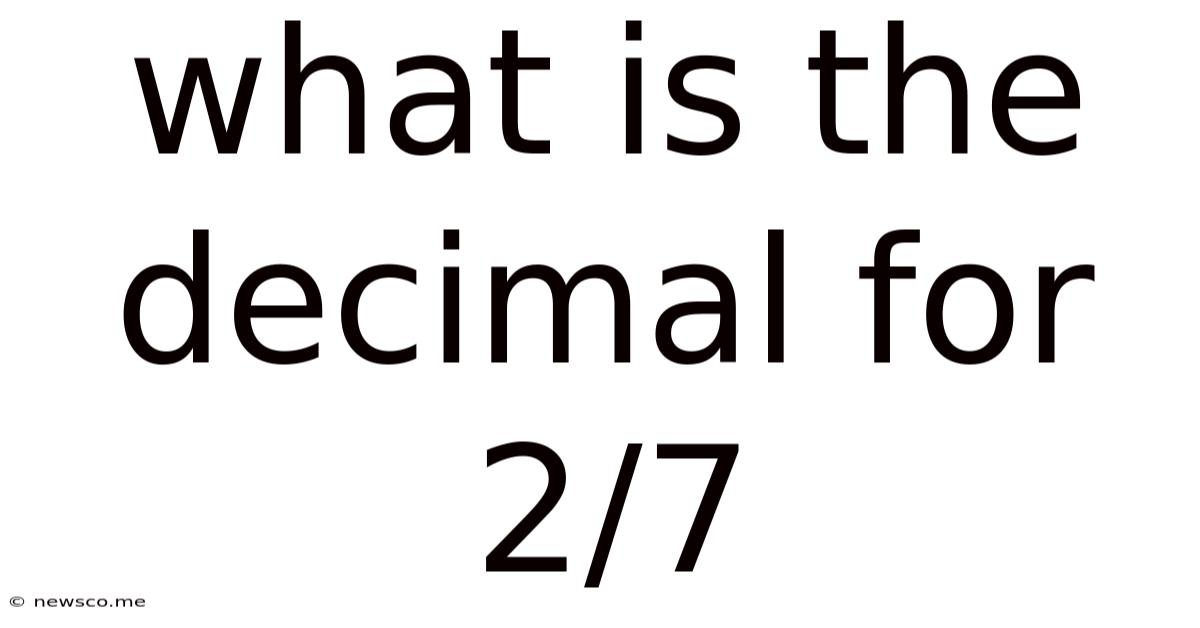What Is The Decimal For 2/7
News Co
Mar 18, 2025 · 4 min read

Table of Contents
What is the Decimal for 2/7? A Deep Dive into Fractions and Decimal Conversion
The seemingly simple question, "What is the decimal for 2/7?" opens a door to a fascinating exploration of fractions, decimal representation, and the intricacies of mathematical conversion. While a calculator readily provides the answer, understanding the why behind the result offers a deeper appreciation of mathematical principles and their practical applications. This article will delve into the process of converting 2/7 to its decimal equivalent, exploring different methods, examining the nature of repeating decimals, and discussing the significance of this seemingly basic conversion in various fields.
Understanding Fractions and Decimals
Before tackling the conversion, let's establish a firm understanding of fractions and decimals. A fraction represents a part of a whole, expressed as a ratio of two integers: the numerator (top number) and the denominator (bottom number). For instance, in the fraction 2/7, 2 is the numerator and 7 is the denominator. This signifies two parts out of a total of seven equal parts.
A decimal, on the other hand, represents a number based on the powers of 10. Each digit to the right of the decimal point represents a decreasing power of 10: tenths, hundredths, thousandths, and so on. Decimals offer an alternative way to express fractions, making calculations and comparisons sometimes easier.
Converting 2/7 to a Decimal: The Long Division Method
The most fundamental method for converting a fraction to a decimal is long division. We divide the numerator (2) by the denominator (7):
0.285714...
7 | 2.000000
-14
60
-56
40
-35
50
-49
10
-7
30
-28
2...
As you can see, the division process continues indefinitely. The remainder keeps reappearing, leading to a repeating decimal. The decimal representation of 2/7 is approximately 0.285714, with the sequence "285714" repeating infinitely. This is often denoted as 0.285714... or 0.285714 with a bar over the repeating digits (0.2̅8̅5̅7̅1̅4̅).
Why the Repeating Decimal?
The reason 2/7 results in a repeating decimal lies in the nature of the denominator, 7. When a fraction's denominator contains prime factors other than 2 and 5 (the prime factors of 10), the decimal representation will be a repeating decimal. Since 7 is a prime number and not 2 or 5, the division doesn't terminate neatly.
Alternative Methods for Conversion
While long division is the most fundamental approach, other methods can help understand the conversion process and potentially provide quicker approximations:
-
Using a Calculator: A simple calculator directly provides the decimal approximation of 2/7. However, the calculator may truncate or round the repeating decimal, showing only a finite number of digits.
-
Conversion to a Common Denominator (for comparison): While not directly converting to a decimal, finding a common denominator with a power of 10 can provide an approximate decimal representation. This isn't practical for 2/7, as finding a power of 10 divisible by 7 is impossible.
Significance and Applications of Decimal Representation
The decimal representation of 2/7, despite its seemingly simple nature, holds practical significance across numerous fields:
-
Engineering and Physics: Precision in calculations is paramount in engineering and physics. Understanding and managing repeating decimals ensures accuracy in calculations related to measurements, ratios, and proportions.
-
Finance and Accounting: Accurate financial calculations rely on precise decimal representations. Working with fractions like 2/7, for example, might be essential when dealing with fractional shares or complex financial instruments.
-
Computer Science: Computers often work with binary numbers, but understanding decimal representations is crucial for inputting data, interpreting outputs, and ensuring accurate computations within programs. Representing repeating decimals efficiently is a challenge addressed through various algorithms.
-
Everyday Life: Even seemingly simple situations might involve fractions. Dividing a pizza into 7 slices and taking 2 would involve working with the fraction 2/7 and its decimal equivalent.
Understanding Repeating Decimals: Period and Repetend
Repeating decimals have a specific structure. The period is the number of digits in the repeating block. In the case of 2/7, the period is 6 because the repeating block "285714" has six digits. The repeating block itself is called the repetend.
Understanding the period and repetend helps predict the behavior of repeating decimals and manage them efficiently in computations and software applications.
Advanced Concepts: Continued Fractions
For a deeper understanding, we can represent 2/7 as a continued fraction. Continued fractions provide an alternative representation of numbers, especially useful for expressing rational numbers (fractions) and approximating irrational numbers. The continued fraction representation of 2/7 is straightforward: [0; 3, 1, 1, 1, 2]. While beyond the scope of this basic conversion, exploring continued fractions provides further insight into number theory.
Conclusion: Beyond the Simple Calculation
The seemingly simple question, "What is the decimal for 2/7?" uncovers a rich tapestry of mathematical concepts and applications. From understanding the long division process and the nature of repeating decimals to exploring alternative representations and practical applications, the journey reveals the intricate beauty and power of mathematics. The decimal representation of 2/7, while approximately 0.285714..., represents much more than just a number; it embodies fundamental mathematical principles with far-reaching consequences in various fields. The precise understanding and management of these concepts are essential for accurate and efficient problem-solving in diverse areas of study and application.
Latest Posts
Related Post
Thank you for visiting our website which covers about What Is The Decimal For 2/7 . We hope the information provided has been useful to you. Feel free to contact us if you have any questions or need further assistance. See you next time and don't miss to bookmark.